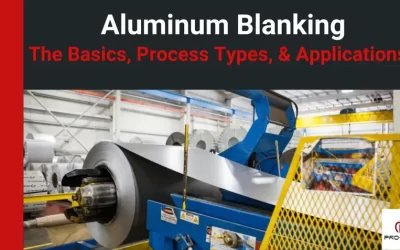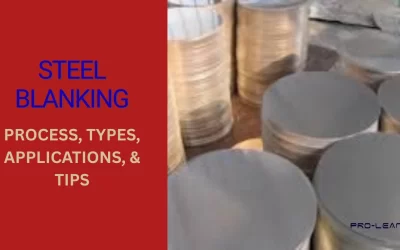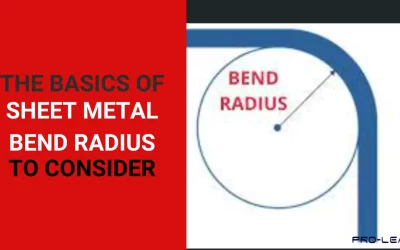
Aluminum stamping is a critical process to decrease vehicle weight. It enhances fuel usage while reducing carbon emissions. As a result, lighter parts are being created by replacing steel with aluminum alloys. The weight reduction does not affect the safety of the BiW(Body in White) structure.
ProLean exploits advanced software, and an extensive database of aluminum alloys. So, the latest tools, and technology enable to bring for superior aluminum stamped parts. Stamped aluminum parts are more prone to springback than stamped steel ones. Proper compensation for springback is attained by employing advanced software at ProLean. In addition to quality, they ensure, parts must meet certain production tolerances in the production line. Some common products manufactured include, body side apertures, outer panels, and closures, well-suited to aluminum alloys. These products are also involved in the structural parts of vehicles.
Aluminum Metal Stamping Process

Aluminum stamping process
Metal stamping refers to several forming processes, typically used to transform a standard aluminum product into smaller parts. Different techniques involved in the aluminum metal stamping process are given by:
- Blanking: The blanking process forms a die to cut out a workpiece from an aluminum sheet metal piece. The process gives clean blanks that may undergo additional operations with the help of a stamping press or types of equipment.
- Piercing: Piercing uses a punch and die to cut small slots, notches, or holes into the part. Piercing provides small clearance dimensions which produce cleaner edges than drilling. Piercing is normally considered more effective than laser cutting.
- Deep Drawing: The drawing process employs tensile force to give the components, the required shapes and thickness. It is done by gradually extending the blanks over a die to change their shape. Deep drawing is commonly used in the fabrication of various electronic devices.
- Forming: The term forming is a general one that covers techniques and processes used to shape or form blanks.
Try Prolean Now!
Explaining Aluminum Stamping Techniques
Stamping is a broad term. It has various ways of fabrication. These techniques enable you to form aluminum sheet metal into any desired form.
Blanking Aluminum

Aluminum blanking process
In the blanking process, you remove parts of the aluminum sheet by using stamping tools. Usually, dies are often employed to eradicate the needed design from the workpiece. While punching only knocks out the unwanted parts. Blanking takes out the required part of the aluminum sheet.
Piercing Aluminum
Piercing is a process of making holes or notches on aluminum sheets by using punches and dies. It accurately shapes the needed forms on blank aluminum sheets with high dimensional accuracy.
Coining Aluminum
Coining is another aluminum bending process in which the sheet metal is put between the punch and the die. It is possible to force aluminum into an L, V, or U shape. The coining method is also classified as the aluminum stamping method.
Aluminum Deep Drawing

Aluminum deep drawing process
Deep drawing is a process of giving tension to form deep impressions on the aluminum surface. The method forces the aluminum into a cavity to produce deeper shapes. While stretching could be a challenging process, so requires expertise for minimum distortion.
Embossing Aluminum
In the embossing process, you can create high or low profiles on aluminum. The tooling system imprints the required designs on the metal. Embossing offers high levels of detail in the pattern/design creation.
Flanging Aluminum

Aluminum flanged parts
Flanging involves the use of tools to put a flange or flare on an aluminum surface. This process is employed to develop structural elements in stamped components and/or to form undercuts.
Aluminum Stamping Operations
There are four key aluminum stamping operations to consider:
- Aluminium Progressive Die Stamping
Progressive die stamping uses a set of dies to complete certain operations. Copper goes through several processes, sequentially, as the metal feeds through the machine, or rather, aluminum. In each die station, there is specific work is done, so that it can run efficiently. The final die is used to delineate the final part from the scrap metal. Aluminum progressive die stamping can be well used for a large number of production runs. Moreover, used for the transfer of die staking from one location to another.
- Aluminum Transfer Die Staking
Transfer die stamping is a process whereby parts are shifted from one position to the other using mechanical means. Following the first stamping process, the cross-sectional area of a particular shape is disconnected from the main plate. They are then subsequently conveyed to other stamping stations. This technique is best applied in large parts of aluminum that may need further processing.
- Aluminum Four-slide Stamping
Four-slide stamping uses several sliding tools to produce intricate shapes in the workpiece. The process is well-suited for designs with high complexity, as it permits multiple deformations at once. Moreover, aluminum metal stamping costs are cheaper, and ideal for large-scale production, as requires minimal time to produce. Four-slide stamping is flexible in design making it easier for manufacturers to produce a large array of aluminum parts.
- Aluminum Fine Blanking
Fine blanking forms aluminum parts with exact measurements. It produces no burrs on the part periphery. Further, blanking reduces the burr formation giving tight tolerance, required for quality application. It is mainly helpful in aerospace, and automotive for high dimensional applications. So, fine blanking offers the best solution for intricate aluminum parts.
Benefits of Stamped Aluminum Parts
Stamped aluminum parts create a good surface finish, appropriate for additional operations such as painting and powder coating. Since aluminum has an exceptional strength-to-weight ratio, so frequently used to make aerospace hardware.
Because of its exceptionally high thermal conductivity, it is considered among the perfect stamping materials for the manufacture of cooking utensils and heat sinks. Moreover, aluminum offers good electrical conductivity. Additionally, it has solid performance properties in low-temperature conditions, keeping high strength and ductility. The aluminum oxide(Al2O3) coating on aluminum provides an outstanding shield against corrosion to adore harsh environments.
In addition, aluminum is a non-toxic, inorganic, reflective, and relatively convenient-to-form material. Nonetheless, it is often more expensive than steel. The process of welding aluminum is a challenge that can necessitate added pre-treatments. However, some particular types of aluminum alloys cannot stand up to heat treatment, which creates a restriction on how they can be utilized.
Aluminum Alloys For Metal Stamping
The common grades of aluminum for the aluminum stamping process are mentioned below;
1100 Aluminum Alloy
Characteristics: Alloy 1100 is simple to form, incredibly flexible, and has outstanding corrosion resistance. Made up of pure 99% aluminum.
Applications: Use in ornamental goods, and food packaging.
3003 Aluminum Alloy
Characteristics: Exhibits quality mechanical properties including high corrosion resistance and comparatively stronger than alloy 1100 but can be easily formed.
Applications: Customarily found in chemical equipment and kitchen аппаратура. Also used for generic sheet metal projects.
5052 Aluminum Alloy
Characteristics: Alloy 5052 is protected from corrosion by salt water. Has high endurance strength in applications that are difficult to tolerate stress.
Applications: Thanks to its strength, titanium is suitable for utility in marine areas, for automotive parts, and as part of aircraft fuel tanks.
6061 Aluminum Alloy
Characteristics: Al 6061 is valued for its adaptability, heat treatment qualities, weldability, and low corrosion properties. After anodizing, it generates a decent surface finish.
Applications: Commonly found in buildings, cars, aircraft, spacecraft, and shipbuilding.
Try Prolean Now!
Challenges with Stamping Aluminum Parts
Here are some of the common challenges encountered in the aluminum stamping process;
Galling
Galling is a common problem in stamping aluminum. This is where aluminum sticks to the stamping tools and leads to surface defects of the parts. So, make sure to use appropriate greases and contaminated-free tools. Other coatings such as titanium nitride on tools can also be used to minimize the adhesion of aluminum to surfaces.
Springback

Springback Phenomenon
Aluminum also has a higher spring back than other metals when a bending force is applied to it. The parts do not hold the shape, expected of them to hold. To avoid this, you need to practice a lot of control in the stamping process. It’s also possible to modify the tool design and use software simulations to estimate and compensate for springback.
Wrinkling

Wrinkling
Wrinkling is a major problem in stamping, particularly in deep drawing. It happens, because of the compressive stress acting on the aluminum sheet. Reducing the wrinkling is possible by controlling the blank holder pressures and optimizing the tooling design. Moreover, it can be prevented by ensuring the material is distributed uniformly during the stamping process.
Tearing

Tearing in stamping
Tearing is a splitting issue. It usually happens to the aluminum sheet when the material is over-stressed during the stamping. To prevent this, the rate at which the material is deformed has to be well-regulated. Further, it’s important to select an aluminum grade with good elongation value. You can also try to optimize the tooling design to minimize tearing.
Tool Wear
Aluminum is a tough material and tends to wear out tools used for its manipulation. It can decrease the life of the stamping tools. Tool wear can be avoided by using good-quality tool materials and applying a protection layer on tools. Protection can also minimize breakdown and as well assist in enhancing the life of the tools together with the quality of the parts.
Applications of Aluminum Metal Stamping
Custom metal stamping is used across aerospace, automotive, construction, and medical sectors.
Aerospace
Aluminum stamped parts are ideal, where weight is not a compromised concern. It’s easy to handle, lightweight, and possesses high mechanical strength, making it ideal for use in aircraft components. Aluminum stamping is used in manufacturing fuselage and wings, and the internal mechanisms. It helps to decrease the total weight of the aircraft and as a result, improve the aircraft and fuel efficiency.
Medical Equipment
Aluminum stamping is a particularly significant process for providing accurate, and precise medical components. Aluminum alloys are typically used in surgical instruments, diagnostic equipment, and patient transfer equipment. These parts facilitate the defense of cleanliness and reliability which are very crucial in the healthcare sector.
Construction and Architecture
Aluminum stamping is applied to frames, panels, and structural members in the construction of structures. These properties make it suitable for use in the contemporary architectural designs of many buildings.
Food and Beverage Industry
Aluminum is non-toxic. Also, it does not corrode easily. Therefore used in the manufacture of food and beverage containers. In addition, it’s applied in equipment where heat provision is critical, in the food processing and storage industries.
Automotive Sector
In the automotive industry, it is always a question of efficiency and safety. Aluminum-stamped parts are used in car frames, panels, and engine components. They offer the support without making the car heavier which in turn will improve the fuel consumption and car toxic emissions.
Electronics
Aluminum is an excellent conductor of electricity and heat, a property that is vital in the production of electronic equipment. It can be applied in the housing of electronic devices and computer heat sinks. Aluminum stamping provides both the form and the strength in the electronics industry.
ProleanTech Capabilities in Producing Stamped Aluminum Parts
ProleanTech is your trustworthy custom aluminum metal stamping service provider. Having many years of experience and knowledge in aluminum stamping, our professionals are prepared to take on all your metal stamping needs.
You can rely on ProleanTech for quality results if you need accurate tolerances, in-house tooling designs, prototype formation, or high-volume production.
Over time, ProleanTech has developed knowledge of several metal stamping methods, surface finishing processes, and quality inspections that are rigid and thorough. We commit to providing outstanding quality aluminum parts at your constrained budget.
Try Prolean Now!
Final Summary
Aluminum stamping is a flexible metal fabrication process with numerous techniques available. ProleanTech guarantees that all stamped aluminum parts are produced with the greatest accuracy and quality. Please feel welcome to get in contact with us to ask any questions about fulfilling your production requirements.
Stamping Aluminum FAQs
Q1. What is Aluminum Stamping?
A process in metal fabrication called aluminum stamping uses dies to produce forms and patterns in aluminum sheets.
Q2. Is Aluminum Good for Stamping?
Absolutely.
Highly workable and excellent strength are both characteristics of aluminum. It can quite easily be shaped and stamped into a collection of designs.
Q3. How do you select aluminum alloy for stamping?
When selecting aluminum alloys, several factors are important:
- Application requirements
- Strength needs
- Corrosion resistance
- Formability
- Machinability and weldability
- Alternatives to surface treatment such as anodizing or powder coating
- Material availability
Q4. Can You Anodize Stamped Aluminum Sheets?
Yes.
Aluminum parts manufactured with stamping and subsequently anodized exhibit improved corrosion resistance in corrosive areas. It can be used along with powder coating or painting to add extra protection.
Q5. Are special lubricants required for stamping aluminum?
Indeed, specific lubricants are essential for aluminum stamping. Search for oil-free and synthetic options that perform well in both light and heavy stamping.
Q6. Which Stamping Presses are Best for Aluminum Fabrication?
You can use:
- Mechanical stamping presses
- Hydraulic stamping presses
- Mechanical servo presses
Q7. Is the use of Specialized Dies necessary for stamping aluminum?
Aluminum’s superb workability suggests that standard dies, like plain carbon steel, are commonly adequate. For tooling, you can choose from:
- Single Station Dies: Offered in combination or compound dies. Combination dies perform both non-cutting and cutting jobs in a single action, while compound dies are cut multiple times in a single operation.
- Multi-Station Dies: Employed for series production of aluminum goods in a systematic process.




0 Comments